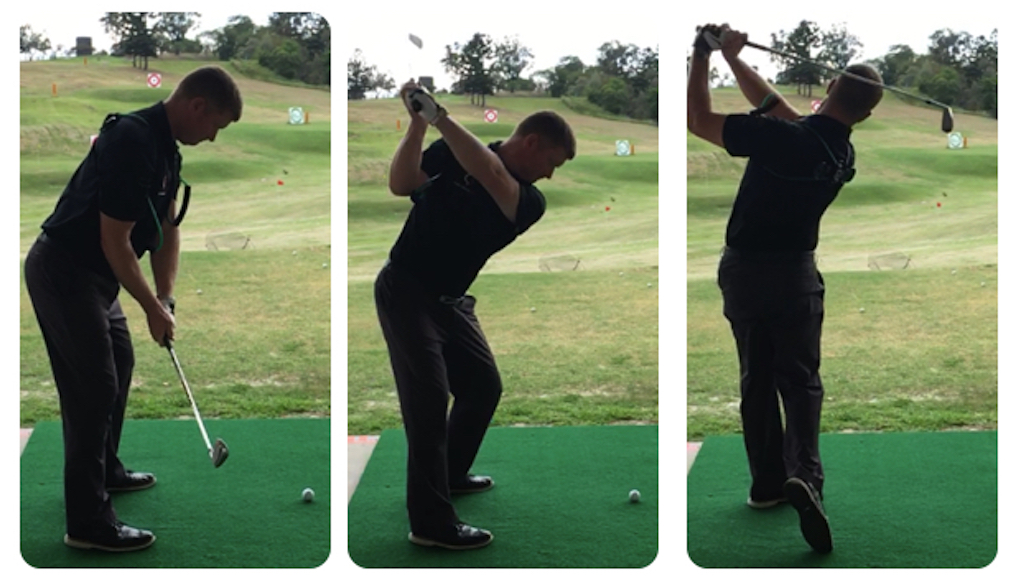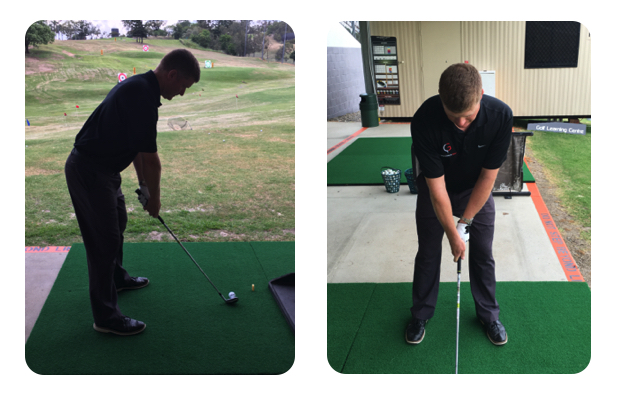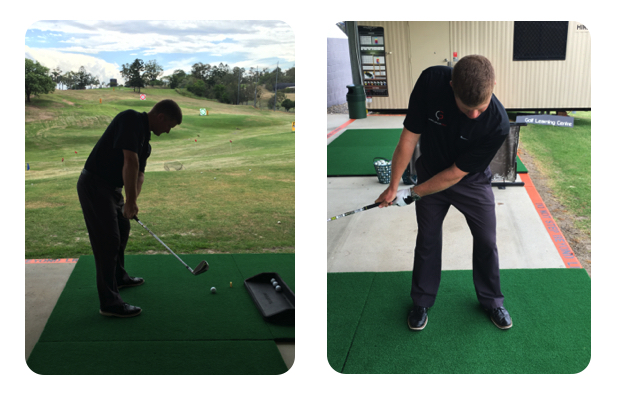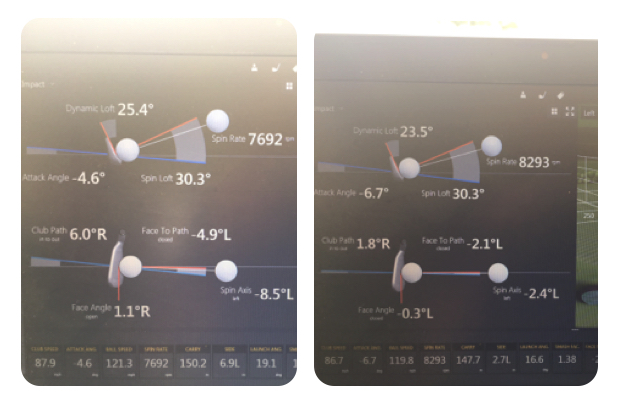Instruction
How your shoulder blades can affect your clubface: Part 1

This article was co-authored with Chris Gibson, an Australian AAA-rated golf professional. His teaching philosophy centers on simplicity and longevity in the game, providing help for golfers at all levels. He focuses on interpreting information from technology and applying it in the simplest way possible to help his students.
The shoulder blade (scapula) is a strange bone, quite unlike any other in the body. It seems to float in a sea of 17 different muscles that attach to it without possessing any tangibly useful function. Not many people know why it’s there or really what to do with it.
Despite its odd appearance and awkward location, the scapula actually has a really important job to do, that of attaching the upper arm to the rest of the body. The muscles that run from the scapula to the upper arm essentially control movement at the shoulder, so the scapula has a pretty crucial role as far as most sporting actions are concerned, especially golf.
We (Chris and I) like to think of the relationship between the scapula and the clubface from a top-down, chain reaction perspective:
Scapula – Gleno Humeral Joint (shoulder) – Upper Arm – Elbow – ForeArm – Wrist – Grip/Shaft – ClubFace
If you change something at the scapula, then this will have a chain reaction down the line. For instance, in the photo below, Chris is downwardly rotating his right scapula, which internally rotates the shoulder. That pronates the elbow and wrist and shuts the clubface. He demonstrates what this often looks like at address and also what commonly happens as a result in a golfer’s first move, especially with better players.
At Address
 Common First Move
Common First Move
A re-routing of the club needs to happen at some point during the swing to produce workable conditions from here — think Ryan Moore as an extreme example. This will usually result in a club being delivered from the inside (see the data on the left in the image below).
Yes, it’s possible to manipulate any of the segments down the chain from the the scapula (and/or other parts of the body) in order to produce a different result at the clubface, but if we are chasing consistency of action and repeatability of strike, plus avoidance of injury, we believe that the less manipulation that occurs the better. We would prefer to see something more like the data on the right in the image below (apologies for the poor quality).
Common Questions, Queries, Arguments
- What does clubface positioning have to do with anything??
It will come as no surprise that the position of the clubface at impact will have a very big influence on where your golf ball goes. In fact, the revised ball flight laws state that with the driver — provided there is no interference from off center strikes (a.k.a gear effect) — 75 percent of starting direction is dictated by clubface.
- So what if my clubface isn’t perfect position. Can’t I just rely on skill and timing to square the clubface up at impact?
Some people do a great job of manipulating their body through impact to recover from less than ideal clubface control, but they tend to be the really talented ones. The majority of the population simply doesn’t have the skill/timing to do this repeatedly or they don’t practice nearly enough to make it habitual. An analogy I like is that of the highly talented race car driver being able to handle a car going into a 100 mph chicane from the wrong position. They will keep it on the track 9 out of 10 times. Most of us mere mortals could really benefit from being on the correct racing line, otherwise, we are going straight into the tires 9 out of 10 times!
Takeaway
The basic premise is this: control your shoulder blades better and you will find it much easier to control your shoulder, arm, wrist, shaft and ultimately your clubface, which will help you produce more consistent and repeatable shots.
In Part 2 of this article (coming soon), Chris and I will show you how you can develop better stability and control of your shoulder blades.
- LIKE85
- LEGIT13
- WOW3
- LOL4
- IDHT3
- FLOP9
- OB2
- SHANK58
Instruction
Clement: Laid-off or perfect fade? Across-the-line or perfect draw?

Some call the image on the left laid off, but if you are hitting a fade, this could be a perfect backswing for it! Same for across the line for a draw! Stop racking your brain with perceived mistakes and simply match backswing to shot shape!
- LIKE0
- LEGIT0
- WOW0
- LOL0
- IDHT0
- FLOP0
- OB0
- SHANK1
Instruction
The Wedge Guy: The easiest-to-learn golf basic

My golf learning began with this simple fact – if you don’t have a fundamentally sound hold on the golf club, it is practically impossible for your body to execute a fundamentally sound golf swing. I’m still a big believer that the golf swing is much easier to execute if you begin with the proper hold on the club.
As you might imagine, I come into contact with hundreds of golfers of all skill levels. And it is very rare to see a good player with a bad hold on the golf club. There are some exceptions, for sure, but they are very few and very far between, and they typically have beat so many balls with their poor grip that they’ve found a way to work around it.
The reality of biophysics is that the body moves only in certain ways – and the particulars of the way you hold the golf club can totally prevent a sound swing motion that allows the club to release properly through the impact zone. The wonderful thing is that anyone can learn how to put a fundamentally sound hold on the golf club, and you can practice it anywhere your hands are not otherwise engaged, like watching TV or just sitting and relaxing.
Whether you prefer an overlap, interlock or full-finger (not baseball!) grip on the club, the same fundamentals apply. Here are the major grip faults I see most often, in the order of the frequency:
Mis-aligned hands
By this I mean that the palms of the two hands are not parallel to each other. Too many golfers have a weak left hand and strong right, or vice versa. The easiest way to learn how to hold the club with your palms aligned properly is to grip a plain wooden ruler or yardstick. It forces the hands to align properly and shows you how that feels. If you grip and re-grip a yardstick several times, then grip a club, you’ll see that the learning curve is almost immediate.
The position of the grip in the upper/left hand
I also observe many golfers who have the butt of the grip too far into the heel pad of the upper hand (the left hand for right-handed players). It’s amazing how much easier it is to release the club through the ball if even 1/4-1/2″ of the butt is beyond the left heel pad. Try this yourself to see what I mean. Swing the club freely with just your left hand and notice the difference in its release from when you hold it at the end of the grip, versus gripping down even a half inch.
To help you really understand how this works, go to the range and hit shots with your five-iron gripped down a full inch to make the club the same length as your seven-iron. You will probably see an amazing shot shape difference, and likely not see as much distance loss as you would expect.
Too much lower (right) hand on the club
It seems like almost all golfers of 8-10 handicap or higher have the club too far into the palm of the lower hand, because that feels “good” if you are trying to control the path of the clubhead to the ball. But the golf swing is not an effort to hit at the ball – it is a swing of the club. The proper hold on the club has the grip underneath the pad at the base of the fingers. This will likely feel “weak” to you — like you cannot control the club like that. EXACTLY. You should not be trying to control the club with your lower/master hand.
Gripping too tightly
Nearly all golfers hold the club too tightly, which tenses up the forearms and prevents a proper release of the club through impact. In order for the club to move back and through properly, you must feel that the club is controlled by the last three fingers of the upper hand, and the middle two fingers of the lower hand. If you engage your thumbs and forefingers in “holding” the club, the result will almost always be a grip that is too tight. Try this for yourself. Hold the club in your upper hand only, and squeeze firmly with just the last three fingers, with the forefinger and thumb off the club entirely. You have good control, but your forearms are not tense. Then begin to squeeze down with your thumb and forefinger and observe the tensing of the entire forearm. This is the way we are made, so the key to preventing tenseness in the arms is to hold the club very lightly with the “pinchers” — the thumbs and forefingers.
So, those are what I believe are the four fundamentals of a good grip. Anyone can learn them in their home or office very quickly. There is no easier way to improve your ball striking consistency and add distance than giving more attention to the way you hold the golf club.
More from the Wedge Guy
- The Wedge Guy: Golf mastery begins with your wedge game
- The Wedge Guy: Why golf is 20 times harder than brain surgery
- The Wedge Guy: Musings on the golf ball rollback
- LIKE88
- LEGIT14
- WOW6
- LOL1
- IDHT0
- FLOP4
- OB1
- SHANK8
Instruction
Clement: Stop ripping off your swing with this drill!

Not the dreaded headcover under the armpit drill! As if your body is defective and can’t function by itself! Have you seen how incredible the human machine is with all the incredible feats of agility all kinds of athletes are accomplishing? You think your body is so defective (the good Lord is laughing his head off at you) that it needs a headcover tucked under the armpit so you can swing like T-Rex?
- LIKE0
- LEGIT2
- WOW2
- LOL0
- IDHT0
- FLOP0
- OB0
- SHANK2
-

 19th Hole3 weeks ago
19th Hole3 weeks agoDave Portnoy places monstrous outright bet for the 2024 Masters
-

 19th Hole1 week ago
19th Hole1 week agoJustin Thomas on the equipment choice of Scottie Scheffler that he thinks is ‘weird’
-

 19th Hole3 weeks ago
19th Hole3 weeks agoTiger Woods arrives at 2024 Masters equipped with a putter that may surprise you
-

 19th Hole1 week ago
19th Hole1 week ago‘Absolutely crazy’ – Major champ lays into Patrick Cantlay over his decision on final hole of RBC Heritage
-

 19th Hole2 weeks ago
19th Hole2 weeks agoTwo star names reportedly blanked Jon Rahm all week at the Masters
-

 19th Hole2 weeks ago
19th Hole2 weeks agoReport: LIV Golf identifies latest star name they hope to sign to breakaway tour
-

 19th Hole2 weeks ago
19th Hole2 weeks agoNeal Shipley presser ends in awkward fashion after reporter claims Tiger handed him note on 8th fairway
-

 19th Hole2 weeks ago
19th Hole2 weeks agoBrandel Chamblee has ‘no doubt’ who started the McIlroy/LIV rumor and why


















krsgolf
Jan 23, 2016 at 8:16 pm
I unfortunately am continually surprised at the lack of respect, ignorance and arrogance shown by posters on this website. Surprised by the utterly tasteless comments posted by people representing a sport that is known for integrity and honesty, and played by ladies and gentlemen. Rather posters act like thugs and cannot respect the opinions and theories posted by authors qualified to some extent to share them with us. Some of these articles surely are complicated, advanced and probably beyond comprehension of the average golfer. But respect the authors and as the old saying goes, “if you don’t have anything nice to say, don’t say anything at all.”
Jamie
Jan 21, 2016 at 7:48 am
Had a look at the suggested video: https://www.youtube.com/watch?v=LupdHXlY4Xw
Can you please tell me:
What research was done to show this works?
Where can I read about it – Journal paper, Medical books, Physical therapy books and articles.
I am considering doing an exercise science degree so I have a scientific understanding of how the body works, so I am looking for all the information I can get.
Where did you do your university degree?
Nick Randall
Jan 21, 2016 at 7:43 pm
Hi Jamie,
Science comes from Dr Carolyn Richardson – http://gravityfit.com.au/scientific-publications-dr-carolyn-richardson/
We are applying this research using their exercise tools to help train golfers to move better.
Exercise Science degree definitely worth pursuing.
My Strength and Conditioning qualifications come through the Australian Strength and Conditioning Association (also currently studying MSc in Strength and Conditioning) and “golf body” knowledge largely from ongoing education through the Golf Australia national program and the physios, coaches and trainers in that circle and practical application with players in last 6 years.
Fahgdat
Jan 19, 2016 at 3:49 am
My shoulders and neck areas hurt just from reading about this
SW
Jan 18, 2016 at 2:03 am
Huh. Wow. And I thought it was the way you hold the club in your hands. What would Matt Kuchar or Jim Furyk say about this? Way to confuse the whole world of amateurs and throw them off their game
Joe
Jan 18, 2016 at 12:55 am
We want Kelvin. Kelvin, Kelvin, Kelvin…
Other Paul
Jan 20, 2016 at 9:54 am
Agreed agreed agreed
JP K
Jan 17, 2016 at 11:40 pm
suffering from scapular, rotator cuff elbow and forearm pain. I need pt. 2 right now !
west
Jan 17, 2016 at 8:55 pm
What about nose hairs? How do nose hairs affect the golf swing???
Courtesy flush
Jan 17, 2016 at 7:53 am
Wait wait. Huh?
devilsadvocate
Jan 16, 2016 at 9:07 pm
What is this a teaser? I have answers but you’ll have to wait till next week to get em!
Other Paul
Jan 16, 2016 at 8:37 pm
I dont like it when articles are in a series when it isn’t necessary. Just make one article. It barely took 2 minutes to read this. Bring on the biomechanics! Hurry up and sign Kelvin Miyahira already for monthly articles.
Joe
Jan 18, 2016 at 12:53 am
I complete agree. This guy is painful
david
Jan 18, 2016 at 12:35 pm
why?
Nick Randall
Jan 18, 2016 at 5:37 pm
Sorry guys, request from the editor to split into 2 articles – next part is coming soon
david
Jan 16, 2016 at 7:52 pm
great article
Joe
Jan 16, 2016 at 7:32 pm
That’s because this guy is clutching at straws
Butch
Jan 16, 2016 at 6:18 pm
This is impossible to understand without better photos or graphics! Pretty poor presentation. Pls try again.
Joe
Jan 16, 2016 at 7:33 pm
That’s because this guy is clutching at straws
Nick Randall
Jan 18, 2016 at 5:36 pm
Hi Butch, this might help further explain what I am trying to get across – https://www.youtube.com/watch?v=LupdHXlY4Xw
Butch
Jan 19, 2016 at 6:14 pm
Thank you. I am sure you know your stuff and have some important information to convey. In Part II, please show me “good” and “bad” positions – I trust your opinion about the consequences, but I cannot determine if I am doing something wrong, and if I am, what do I need to change? The photo of the golfer’s setup looks pretty standard to me. Learn from the criticism: this is tough audience! Regards, Butch.
Other Paul
Jan 20, 2016 at 10:01 am
I agree with this guy. If i read an article on a golf website i want to know to improve from what i read. If I can’t, then why read it? And we are a tough crowd. Especially with plenty of us willing to sit down and take a half hour or more just to read one of Kelvin Miyahiras articles about proper movements of the pelvis (which helped me add 18 MPH btw)
Nick Randall
Jan 20, 2016 at 2:43 pm
I’ll see if it’s still possible to add some extra photos showing good and bad positions in Part 2, thanks for the feedback.
Jamie
Jan 21, 2016 at 2:50 pm
Had a look at the suggested video: https://www.youtube.com/watch?v=LupdHXlY4Xw
Can you please tell me:
What research was done to show this works?
Where can I read about it – Journal paper, Medical books, Physical therapy books and articles.
I am considering doing an exercise science degree so I have a scientific understanding of how the body works, so I am looking for all the information I can get.
Where did you do your university degree?
Nick Randall
Jan 21, 2016 at 4:37 pm
Hi Jamie,
Science comes from Dr Carolyn Richardson – http://gravityfit.com.au/scientific-publications-dr-carolyn-richardson/
We are applying this research using their exercise tools to help train golfers to move better.
Exercise Science degree definitely worth pursuing.
My Strength and Conditioning qualifications come through the Australian Strength and Conditioning Association (also currently studying MSc in Strength and Conditioning) and “golf body” knowledge largely from ongoing education through the Golf Australia national program and the physios, coaches and trainers in that circle and practical application with players in last 6 years.